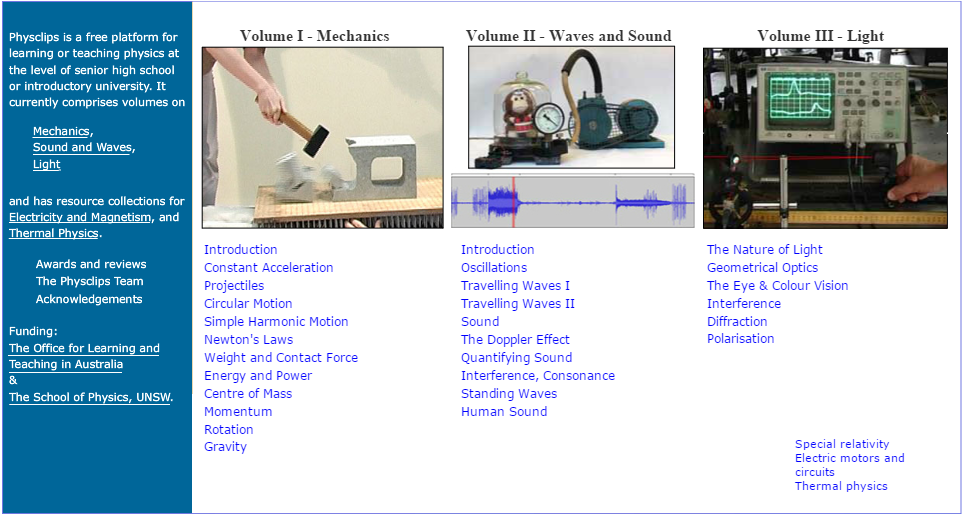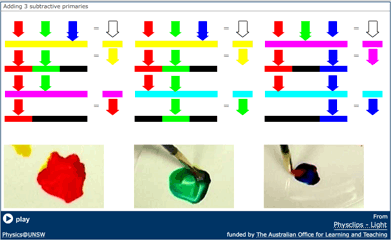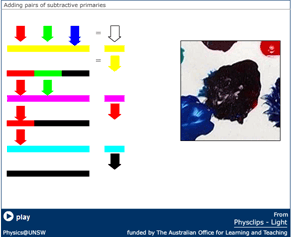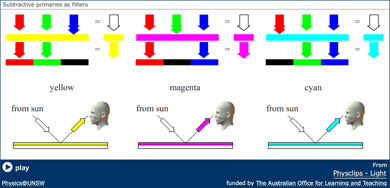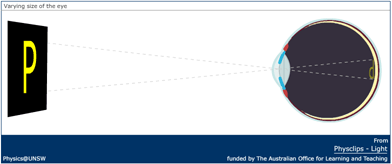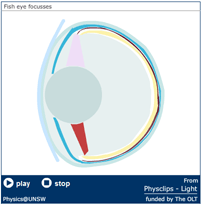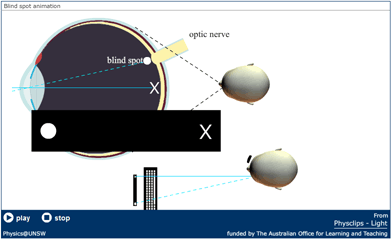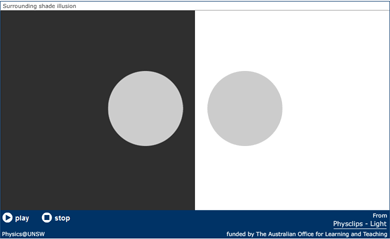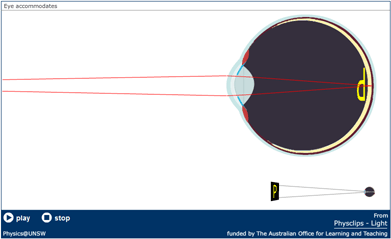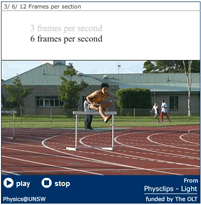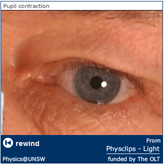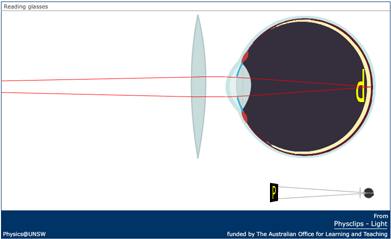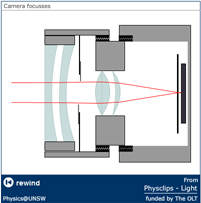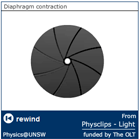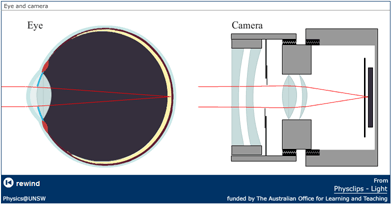jvvsciencefun
especially for science
December 2, 2018
|
| |||||||
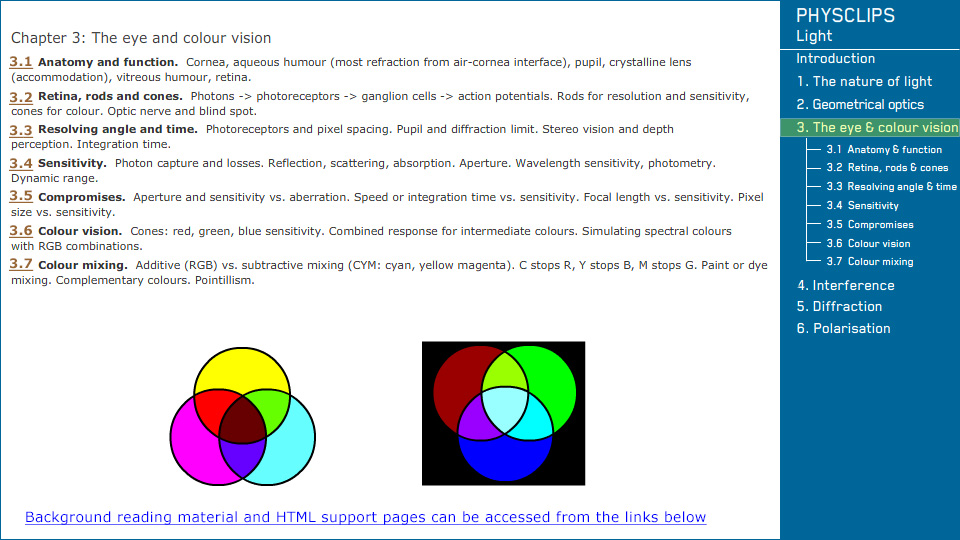 |
| Links to related material | |
| The eye: optics, anatomy and accommodationThe eye and the camera: similarities and differences. Anatomy and focussing. Accommodation and reading glasses. Retinal anatomies. The blind spot. Image formation and analysis. |  |
| Complementary colours, after-images, retinal fatigue, colour mixing and contrast sensitivityAfter-images give complementary colour illusions due to retinal fatigue. Complementary colour charts. Demonstration of contrast sensitivity and lateral inhibition. |  |
| Colour mixingColour mixing with additive primaries (RGB = Red Green Blue) and subtractive primaries (CYM = Cyan Yellow Magenta). Additive mixing using RGB monitors, projectors and Newton's colour wheel. Subtractive mixing using paints and filters. |  |
| The Eye: performance and compromisesPhoton capture efficiency, aperture and aberration, focal length, integration time/ exposure time/ frames per second, stereoscopic vision, angle of view. |  |
| Why vision?Why is the octave from 400 to 700 nm so important? Why so little UR and IV vision? A comparison of vision and hearing. |  |
| Downloads (thumbnails at 50% of size of animation) |
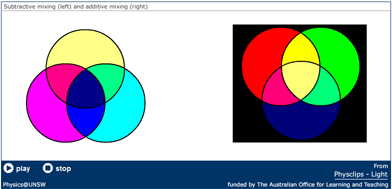 | 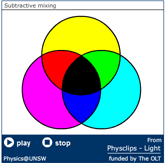 | 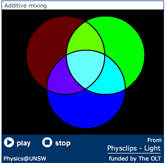 |
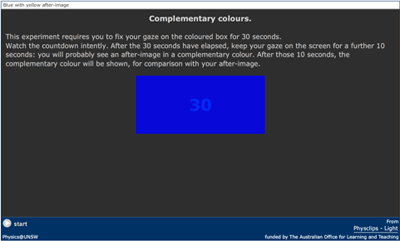 | 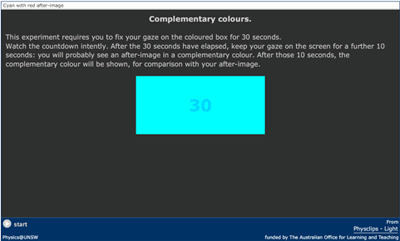 |
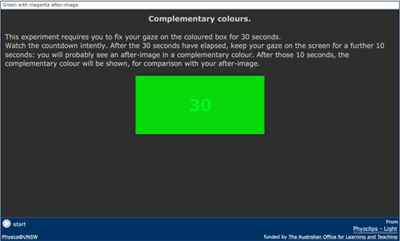 | 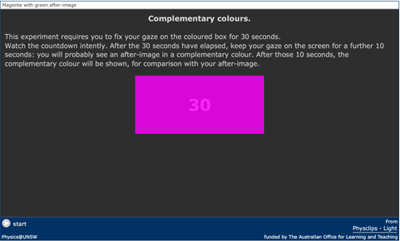 |
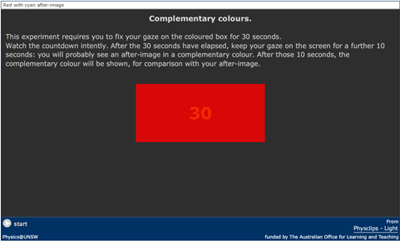 | 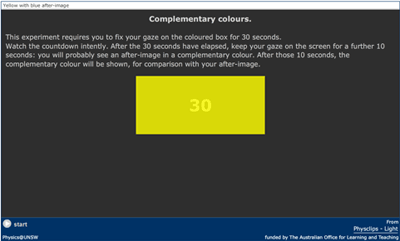 |
| Support for this project website has been provided by The Office for Learning and Teaching, which is part of the Department of Industry, Innovation, Science, Research and Tertiary Education. The views expressed in the project do not necessarily reflect the views of The Office for Learning and Teaching. |
| ||||
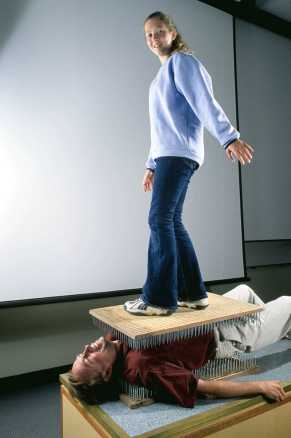
Joe Wolfe: educational pages
|
Pages related to learning and teaching in general
- How to write a PhD thesis. Strangely enough, this is a big hit. Either there are lots of students writing theses, or lots of people procrastinating.
- How to survive a thesis defence.
- Writing and publishing a scientific paper.
- Hints for doing tests. All obvious advice, but it may help.
- Disappointed with your results in your intro physics test? These study hints may help.
- Tips for giving talks: some basic tips written for students who may not have given talks before.
- Some guidelines from the literature, and examples of how we use them.
- Some ideas about using film clips and animations in teaching physics.
Pages on topics in physics
- Pages on Electrical circuits. AC is an area in which animations really are helpful for understanding phase differences and phasor diagrams, so we made some.
- Relativity
- Relativity in ten minutes - or ten hours. Can relativity be understood by someone with little or no background in physics?
"Einstein Light" uses animations and film clips to explain relativity at a range of levels.
- Relativity in ten minutes - or ten hours. Can relativity be understood by someone with little or no background in physics?
- Pages related to quantum physics
- Heisenberg's uncertainty principle and the musician's uncertainty principle.
- The quantum mechanics of cricket.
- Downloadable notes on Bohr and the hydrogen spectrum. A simplified account written for high school or introductory physics students.
- Pages related to thermal physics
- Thermal radiation (and why clothes work).
- Superheating and microwave ovens: why you should be careful boiling water in microwave ovens.
- Boiling and freezing: the effects of solutes and of pressure: a simple, non-technical (biologist-friendly) account.
- The Mpemba effect: why hot water can sometimes freeze faster than cold.
- Pages related to biophysics
- Cellular Thermodynamics a chapter in the Encyclopedia of Life Sciences (http://www.els.net), Nature Publishing Group, London.
- Cryobiology and anhydrobiology The physical causes of cellular damage due to freezing and drying.
- What is 'unfreezable water'?: a question asked by people working in cryobiology and anhydrobiology.
- Membranes: homeostasis and regulation of area and tension: An area of membane mechanics that is suddenly fashionable again.
- Pages on miscellaneous topics in physics (Some of these now moved into Physclips)
- The electromagnetic spectrum.
- FAQ for high school physics, collecting and answering many of the questions put by students, mainly in New South Wales, to the
- Bulletin Board for high school physics.
- An introduction to Netwon's laws, gravity and the orbits of planets.
- The Foucault Pendulum at the University of New South Wales. Does the earth go around the sun and how do you know?
- What are coriolis forces and why do the major ocean currents and winds go clockwise in the Northern hemisphere and anti-clockwise in the South?
- The physics of speech, including helium speech and why it makes your voice sound funny.
- Using a vanilla slice to demonstrate various material properties.
- Cosmology, Teleology and Danish Grandmothers: a critical examination of the argument for design in the universe.
- The physics of sailing: how boats can sail upwind, how they can sail faster than the wind, etc.
- Wheels and rolling: why the rolling point of a wheel is stationary, and what part of a train goes backwards.
- What is the green flash and what causes it?
- How big is a meteor? A simple calculation to determine the size from its perceived brightness.
- The monkey and the hunter. Featuring a slow motion video of this classic physics question.
- A simple introduction to calculus. Some of the most important ideas that will be needed in first year physics.
- Physics questions: a forum for discussing physics questions that fall outside the syllabi of most courses.
Pages on sound, hearing, speech and music
- Music acoustics home page
- Voice acoustics home page
- What is a decibel?
- Measure your own hearing response curve.
- What are interference beats and Tartini tones?
- Helmholtz resonators: How do whistles work? Why does blowing across a bottle make a note?
- Chladni patterns: what are they and what causes them?
- Bows and strings. How bows interact with strings in musical instruments.
- Waves in strings, reflections, standing waves and harmonics.
- How do woodwind instruments work?
- What is a sound spectrum?
- Pipes and harmonics. Why do closed conical instuments (like the oboe and saxophone) have the same set of resonances as open cylindrical instruments (like the flute)? (This seems to be one of the most FAQs in music acoustics.)
- How harmonic are harmonics?(A more subtle FAQ in music acoustics.)
- Note names, MIDI numbers, frequencies and keyboard positions, and translating from one to another.
- Harmonic singing vs normal singing. How sygyt or xoomi singers (from Tuva, Mongolia and elsewhere) make those high, whistling tones.
- An introduction to voice acoustics.
- An introduction to flute acoustics.
- An introduction to clarinet acoustics.
- An introduction to saxophone acoustics.
- An introduction to brass acoustics.
- An introduction to guitar acoustics.
- An introduction to violin acoustics.
- An introduction to didjeridu acoustics.
- An introduction to shakuhachi acoustics.
- An introduction to our work on signal processing with cochlear implants.
- The Science of Music: a series I made for the ABC featuring Dene Olding, Nigel Westlake, Paul Plunkett, Paul Dyer and Colin Piper as guest artists.
Miscellany.
- My blog on the Solar Car Race, from Darwin to Adelaide. UNSW had a great result
- One Night in Afghanistan: an Australian traveller's account.
- Venice: an acoustical paradise. The Sydney Morning Herald, June 16, 2001, p1 of the travel section.
- Cool Scientist. A story about Joe by Stephen Luntz in Australasian Science, March 2006, p47.
- Margaret Throsby did an interview with me for the ABC's The interview.
Material for high school physics students and teachers.
- Interesting and inexpensive experiments for high school physics. Written for teachers and students using the New South Wales syllabus, but more widely applicable.
- FAQ for high school physics. Originally set up for teachers and students using the New South Wales syllabus.
- A Q & A bulletin board for high school physics problems. Originally set up for teachers and students using the New South Wales syllabus.
- A resource exchange forum for physics teachers.
- HSC: 'The World Communicates'. Some information for students and teachers in New South Wales dealing with this syllabus.
- HSC: 'Electric motors and transformers'. Some information for teachers and students in New South Wales dealing with this syllabus.
Material for primary school physics students and teachers.
- Glimpses of science for primary schools. A set of investigations and kits may by Jacinda Ginges, George Hatsidimitris and me.
Joe Wolfe / J.Wolfe@unsw.edu.au, phone 61-2-9385 4954 (UT + 10, +11 Oct-Mar).
 Music Acoustics home page
Music Acoustics home page Joe's scientific home page
Joe's scientific home page Joe's music site
Joe's music siteFormal publications on education
Awards for university and web teaching
The Rossing Prize for Education, the Acoustical Society of America. 2012. UNSW Faculty of Science: Award for Excellence in Teaching and Researchl 2011. The Australian Innovation Award (Education section). Team leader. 2011. Education medal of the Australian Institute of Physics, 2010. 
Physclips has won the Physics Prize of the 2007 Pirelli Prizes for Science Communication. 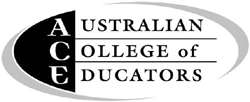
Australian College of Educators Award for University Teaching, 2006. 
Scientific American Science & Technology Web Awards 2005
The editors of Scientific American chose Einstein Light for one of these awards.
Scientific American Science & Technology Web Awards 2005
The editors of Scientific American chose the Music Acoustics website for one of these awards.
Review of Einstein Light in the journal Science, 17 June, 2005. 
The MERLOT Editorial Boards chose the Music Acoustics website as 2005 Editors' Choice Award for exemplary online learning resources. 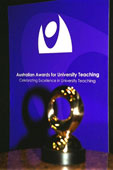
The Australian Award for University Teaching (AAUT) 2004 award for Physical Sciences and Engineering.

Acoustical Society of America AwardThe ASA awarded its 2002 Science Writing Award for Professionals in Acoustics for Introduction to clarinet acoustics. - ViceChancellor's Award for Teaching Excellence, 2002.

Review of Music Acoustics website in the journal Science, 30 November, 2001.

The Music Acoustics website has also been recommended by a range of other organisations, journals and web directories, including the Exploratorium, Physics Today (Feb, 2000), the National Science Teachers Association (USA), the Australian Academy of Science, Librarians' Index to the Internet, Psigate etc. 
Einstein Light has also been recommended by a range of other organisations, journals and web directories, including the Australian Institute of Physics, the Sydney Morning Herald, Yahoo (pick of the day, 22/10/2005) etc.
Subscribe to:
Comments (Atom)



